Podium-Worthy: Olympic Storytelling that Stuck the Landing
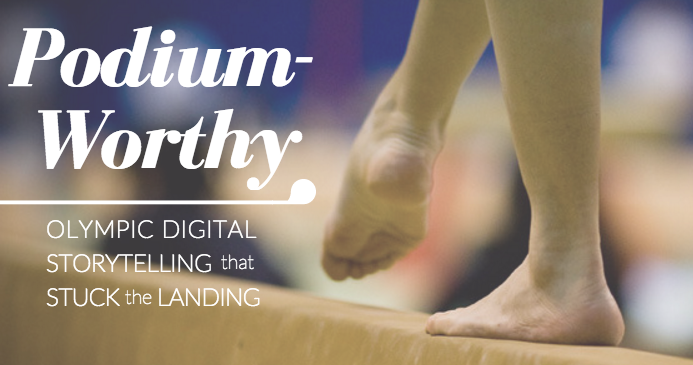
Posted By Marian Hughes on August 30, 2016
By Raphael Goetter - originally posted to Flickr as Poutre, CC BY 2.0, https://commons.wikimedia.org/w/index.php?curid=3771359
As the 2016 Summer Olympics have come to an end, so have the many Olympic-themed campaigns that have been permeating traditional and digital media alike. The Olympics are a marketer’s dream come true; the nature of the Games lends itself perfectly to timely, engaging and interesting content creation. Even with this year’s unprecedented restrictions, brands and businesses were still able to create plenty of podium-worthy content that made us laugh, cry, and Retweet. Here are Tier One’s Olympic digital storytelling picks that went beyond simply reporting the facts and landed themselves a spot atop our Olympic podium:
Bronze Medalists
Our bronze medal picks demonstrate both sides of the emotional content spectrum - and both are winners in their own right.
Procter & Gamble
Procter & Gamble once again showcased its well-honed skill at evoking emotion with the continuation of “Raising an Olympian” as part of its long-standing “Thank You, Mom” campaign. With its reappearance during this year’s Games, these stories once again captivated us with personal video reflections from Olympic mothers sharing inspiring character-developing experiences that shaped their children into the Olympians they are today.
While the inspiring “Raising an Olympian” and “Thank You, Mom” video content shines on its own, P&G strengthened the campaign's impact by giving the “Thank You, Mom” campaign its own Twitter account and Facebook page to share campaign video content alongside other relevant Olympic content. Utilizing social media to present all the content in a single, branded package and tying it into the larger Olympic story made the campaign even more effective. It‘s a great example of how to broaden the reach of branded content and give content a life of its own.
At 13 @Simone_Biles told her mom she wanted to represent the USA. Tonight she leads #TeamUSA bearing the #USA . pic.twitter.com/aEuuYZIAjl
— Thank you Mom by P&G (@ThankYouMom) August 22, 2016
"Growing up, I saw your strength every day.Thanks to you, now the world sees mine." #ThankYouMom #Rio2016 pic.twitter.com/nXSU5v3H3V
— Thank you Mom by P&G (@ThankYouMom) August 19, 2016
It’s a truth (nearly) universally acknowledged that data-driven stats, no matter how useful, can often be written off as boring. That’s what made Google’s fun twist on traditional Olympic stat reporting—sharing statistics and insights in a compelling (and adorable) way—so incredibly refreshing. Along with its “Fruit Games” Google Doodle that garnered attention for its artful dodging of Olympic content restrictions, Google Trends created a string of animated GIFs illustrating what users were searching on the site surrounding the Olympics. Each visual highlighted a search trend, a common question, or a fun fact about the Games. This series was a unique spin on typical Olympics content that came in short, shareable pieces, perfect to spread across social media.
Olympic field hockey brings a surge of people searching for why the turf has water on it. #Olympics #Hockey pic.twitter.com/JXGvLw1ivj
— Google (@Google) August 16, 2016
Searches for neon yellow running shoes in the US spike 600% as Galen Rupp bags bronze in the men’s #marathon. pic.twitter.com/ElsTbUUcmK
— Google (@Google) August 21, 2016
During Olympic Golf, people flock to search and ask what a birdie is. #Golf #Olympics pic.twitter.com/87hF2cNRGg
— Google (@Google) August 17, 2016
Silver Medalists
Interactive content is always a fan favorite, and both of our silver medal picks fall under that category.
The Washington Post
The Washington Post combined an interactive graphic with an educational element in its piece, “Sizing up the Olympics.” The story attempts to give the non-athletes of the world a point of comparison of the size of different Olympic aspects, from equipment all the way to arenas and fields as viewers scroll through. It also throws in some size comparisons to put things in perspective (the dimensions of a large pizza definitely helped us wrap our minds around the size of the Olympic torch!).
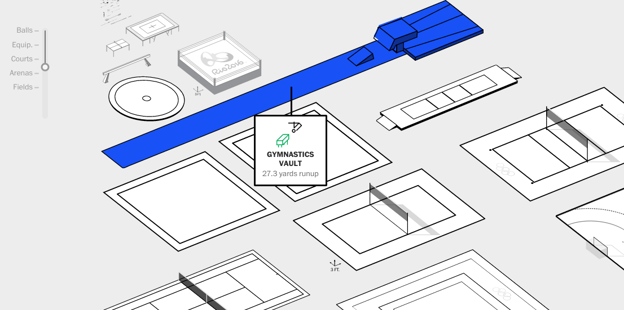
The Wall Street Journal
The Wall Street Journal took its interactive and educational Olympic content a step further with its “Armchair Olympian” piece. This collection of mini-games was designed to test users on skills that are important to various Olympic sports (and show how difficult they truly are). After users complete each game, the piece shares how individuals stack up against Olympian averages. A warning to the competitive among us: don’t start playing these if you have things that need doing.
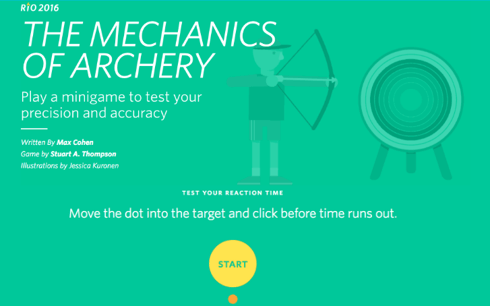
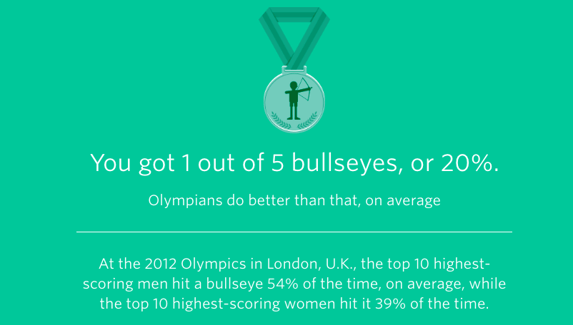
Gold Medalist
The New York Times
The New York Times proved that it’s more of an “All Around” than a “Single Event” storytelling outlet with its engaging collection of Olympic content throughout the Games. From its reaction time game featuring a Usain Bolt comparison to GIF illustrations of the most popular races, NYT was a master of capturing what we love about the Games and transforming that into incredible digital content that enabled us to experience the story in deeper, more meaningful ways.
🇯🇲 Usain Bolt surged late to win the men’s 100 meters for the third time in a row. https://t.co/LAmPdJ6z4F pic.twitter.com/s5SOs3c24s
— NYT Graphics (@nytgraphics) August 15, 2016
Its crown jewel came in the form of an interactive U.S. Olympic athlete highlight series. The four-part series featured gymnast Simone Biles, swimmer Ryan Lochte, high jumper Derek Drouin, and triple-jumper Christian Taylor in a visual culmination that grabbed our attention never let go.
Each story mixes video, visuals, text, and diagrams to paint the full picture of the story behind each extraordinary athlete. So that viewers can move through at their own pace, the content is broken up into pages. With only a small piece of content on each page, the viewer has time to fully digest before moving on, a smart structure that prevents users from skipping (or scrolling) over anything (not that anyone would want to miss a moment of this perfect 10)!
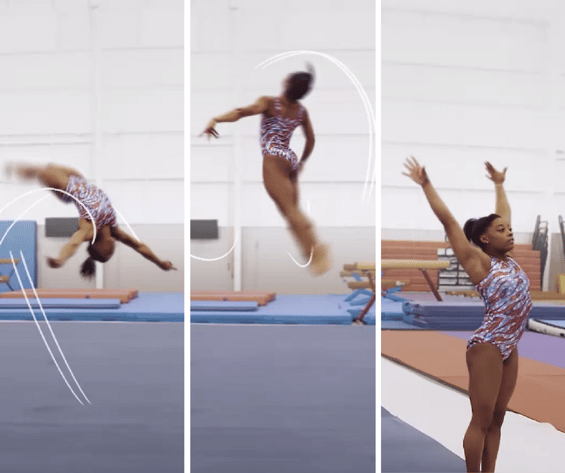
Final Thoughts
Keeping audiences entertained, involved, and always wanting more is the ultimate goal of master storytellers, and these perfectly executed examples raise the bar and demonstrate that impact can be achieved from a multitude of approaches:
- Playing to our emotions with nostalgic, personal content that audiences can relate to and care about.
- Using captivating visuals that grabbed our attention instead of overwhelming with text.
- Utilizing data in a creative way to get at the heart of people’s interests and impart new knowledge.
- Getting us involved with interactive pieces that made us feel part of the action.
- Creating short and sweet social content with visuals and GIFs that inspired us to Retweet and Share.
- Telling the story in more ways than one, keeping us interested, surprised, and awaiting the next and newest thing.
Although we’re sad to see the Games go, these storytelling tips and tricks are applicable far more often than every four years. We’re already looking forward to seeing what master storytellers will come up with for the next round of Olympic competition. We’ll see you (and your content) in 2018!

Marian Hughes
Marian Hughes is a Co-founder and Managing Partner at Tier One, where she leads the agency's Chicago office. With more than 30 years of agency experience, Marian has helped shape communications programs for innovative technology brands since the 1990s dot-com boom. Her greatest love is building and leading agile teams that delight clients with creative programming and breakthrough results. When she is not working, Marian enjoys nature and the outdoors — whether through hiking, gardening, or on the pickleball court.


